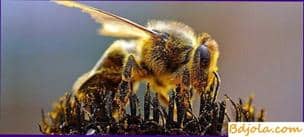
From the bees’ updates, a stock of food is formed – pergu, which after compaction and processing in the cubicles of honeycombs is a dough-like mass. Perga can be kept for a long time and used by the family by the beginning of the spring of next year.
Consuming pollen mainly larvae aged 4-6 days. For them, adult bees are preparing a gruel, which includes pollen. Pollen is also consumed by worker bees, mostly young. This promotes the production of milk for bee larvae of young age and the uterus. To grow 1 kg of bees you need 0,9-1,5 kg of pepper.
With prolonged spring cooling, in autumn and at the end of winter, when bees can not replenish the stocks of pollen, but it is not enough, the possible protein starvation of bees. Under such conditions, families reduce or completely stop raising brood. As a consequence, honey production is reduced, bees do not excrete wax, they are more exposed to diseases, they die earlier.
Соты темного цвета. Крахмал для пчел.
Pollen and Perga